Newborn babies eat only breast milk. At the age of six months, the baby is offered to try zucchini, cauliflower or carrots. Parents, knowing the benefits of vegetables, strive to make the baby's first complementary food as correct as possible and not bring harm to the baby. With which product should the baby's acquaintance with solid food begin, the opinions of pediatricians differ. How to cook carrots for the first feeding at home, if the choice fell on this root crop, every mother should know.
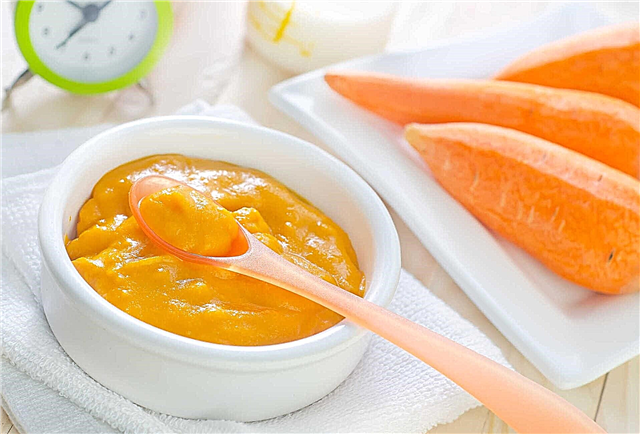
Homemade carrot puree
The benefits of carrot puree
Carrot puree contains many benefits for babies: this root vegetable primarily contains beta-carotene. Vitamin A, important for the baby's health, is synthesized from this source, beta-carotene compounds improve vision, accelerate metabolic processes, form bone tissue, skin cells and mucous membranes.
Important! If the baby receives little provitamin A, then his skin becomes dry, flaky, development and growth slow down, the baby is often sick.
Carrots, like most vegetables, contain fiber as well as pectin. These components accelerate digestion, eliminate bile stagnation and cause a mild laxative effect.
Composition and nutritional value
The root vegetable has a rich composition:
- Provitamin A;
- Vitamin C, which strengthens the immune system and the immune system, promotes easy absorption of iron, improves the functioning of hematopoiesis, fights anemia;
- Magnesium, B vitamins - they help calm the nervous system, improve sleep;
- Potassium - improves the functioning of the cardiovascular system and removes excess fluid from the body;
- Alimentary fiber.
What is the value of carrots:
- strengthening of bone tissue, teeth;
- the work of the heart and blood circulation improves;
- the digestive system starts to work actively;
- strengthens the immune system;
- vision improves;
- the risk of cancer is reduced;
- increased regeneration of liver and kidney cells;
- cleansing the body of toxins and toxins;
- skin condition is getting better;
- energizes;
- low-calorie, but nutritious product, which is why it is recommended for children with increased body weight.
Note! With excessive use of the root vegetable, carotene jaundice may appear (the skin on the palms and feet will turn yellow). This condition is harmless but can cause additional symptoms such as vomiting, nausea, and sleep disturbance.
How to choose the right root vegetable
When choosing carrots for the first feeding, you should choose carefully:
- fruits should be natural, without bends, dense;
- the peel is smooth, bright orange;
- it is better if the root crops have green tops, they should be cut off when they come home;
- do not buy a fruit with a black crown - it has been on the counter for a long time;
- the best choice is medium-sized root vegetables, which taper towards the end, thick specimens will be tough, with an abundance of nitrates.
Additional Information. To avoid the penetration of pesticides into the dish, cut off at least 1 cm of pulp during cleaning.
Rules for choosing store puree
The stores sell a variety of ready-made purees in jars. There are some rules for how to select a product:
- look at the expiration date;
- how tightly the package is closed;
- what is included.

Puree brand "Semper"
It is worth storing such jars either in the refrigerator or in a dark cabinet. It should be understood that the baby will not eat the whole jar. It is recommended not to store such a product after opening, but on the labels you can repeatedly find information that mashed potatoes can be stored in the refrigerator for several days. Before use, the contents are heated in a water bath to 36-37 degrees.
When to start giving
Western and Russian pediatricians disagree about when carrots should be added to complementary foods. In Russia, zucchini and cauliflower are first introduced, and in Europe - carrots. Foreign doctors argue that the benefits of a root crop are many times greater than the likelihood of allergies.
In Russia, it is recommended to introduce mashed carrots from 8-9 months, provided that the baby has already tried zucchini, cauliflower and potatoes.
How to cook properly
The first vegetable dish is mashed potatoes. Cooking methods:
- cook in a saucepan;
- steam;
- use a multicooker or double boiler for quick and uncontrolled cooking.
There are many recipes for mashed carrots for babies, everyone is united by the fact that the finished vegetable should be whipped with a blender. The dish can be prepared for a single use, or it can be prepared for the winter.
Note! To make the vegetable better absorbed, it should be used together with vegetable oil. Therefore, it is permissible to add a teaspoon of olive oil to the finished dish.
Cooking recommendations:
- Children under one year old use the root vegetable only in boiled form or as mashed potatoes. The vegetable should be soft and boiled.
- Raw carrots are given at 1.5 years, it is better to wait three. The child must have enough teeth to chew the hard pulp.
Note! During the teething period, the vegetable can serve as a good "gnawer", but it is important to ensure that the baby does not bite off whole pieces and choke. You can suggest a carrot nibbler.
- From year to year, the vegetable is given in grated form. Previously, such a dish cannot be given - it takes a long time to be absorbed;
- After a year, you can make cutlets, casseroles, salads, cheesecakes and carrot stews for your baby.
Cooking time
How much to cook carrots for complementary foods - at least 20 minutes. The vegetable should be soft so that it can be easily whipped in a blender.
Recipe
Before preparing tender carrot puree, you should prepare the necessary ingredients:
- carrots 100 gr. (it is desirable that it be grown in the garden);
- vegetable oil 3 gr. (preferably unrefined olive);
- water or vegetable broth;
- enameled dishes.
Delicate carrot puree for babies step-by-step recipe:
- The root crop is peeled, washed out and cut into cubes. You can grate, but then less water will be needed.
- The vegetable is poured with water and cooked for 20 minutes over medium heat. Grated carrots can be stewed with water.
- Then cool by throwing in a colander.
- Beat the root vegetable in a blender with a little broth or rub through a sieve.
- At the very end of the whipping, vegetable oil is poured in, and the puree is thoroughly mixed until smooth.
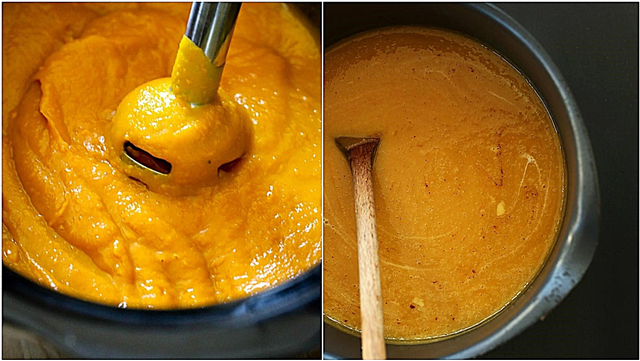
The process of making mashed potatoes
What to combine with
How can you cook carrots for complementary foods - add them to other vegetables when cooking. To make the products easier to digest, you need to know the combination rules.
You can combine a root crop with:
- vegetables: zucchini, potatoes, cauliflower, broccoli, pumpkin;
- fruits: this is an apple, a pear;
- dried fruits: these are raisins, prunes, but they can be given to the baby after a year.
Norms of puree from a vegetable for complementary foods
Dr. Komarovsky, a Russian pediatrician, recommends that mashed potatoes be injected with other vegetables no earlier than 7 months. The kid should try less allergenic foods by this time:
- zucchini;
- potatoes;
- cauliflower;
- broccoli.
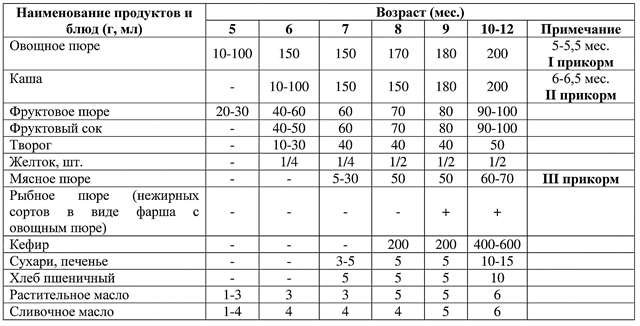
WHO complementary feeding information each month
Note! Children on artificial feeding are allowed to enter mashed carrots 1-2 months earlier.
Also at 7-8 months you can start giving juice from the root vegetable.
Frequency of use and quantity
How often can you give carrot puree to a child under one year old - preferably not to exceed 2-3 times a week. First, the baby is offered a teaspoon of puree in the morning. In the absence of a negative reaction, which manifests itself in the evening of the current day, you can double the next dosage. The volume is gradually brought to 150 grams. by the year.
Juice is offered according to a similar scheme: for the first time a spoon, subsequently increasing the proposed volume. First, it is a one-component juice, then it can be mixed with orange, apple, pumpkin fresh juice, diluted with water in a ratio of 50 to 50.
Note! It is worth observing the baby for 3-4 days. If negative reactions have appeared, then acquaintance with the root crop is postponed for 2 weeks.
Possible problems
During the first feeding, the mother should carefully monitor the well-being of the child. A negative reaction manifests itself in:
- lethargy;
- drowsiness;
- nausea and urge to vomit after feeding;
- if root vegetables are consumed too often, jaundice may appear (the skin and whites of the eyes will turn yellow);
- in rare cases, urticaria and even swelling of the laryngeal mucosa occur.
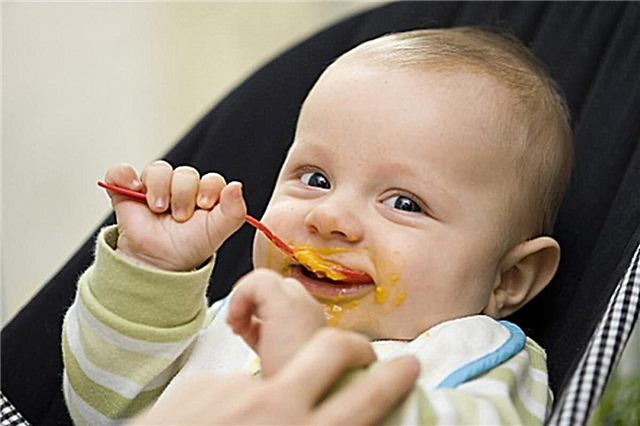
Baby eats carrot puree
Symptoms disappear as soon as the product is eliminated from the diet.
Signs of allergies
An allergic reaction to root crops can appear immediately, maybe after a few hours.
Signs:
- The kid becomes slow, apathetic;
- Troubled by pain in the tummy, diarrhea, nausea or vomiting may begin;
- The skin becomes covered with spots, itches, rashes, irritations greatly disturb the child.
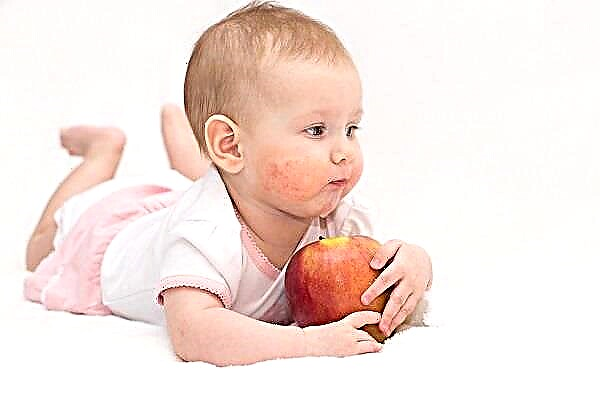
Manifestation of allergies
In winter, making carrot puree for babies is twice as healthy. During the period of infections and viral diseases, it will strengthen the immune defense, add health and invigorate in the harsh cold evenings.



